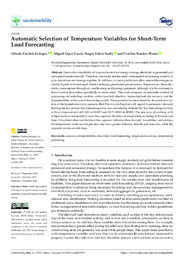Please use this identifier to cite or link to this item:
https://hdl.handle.net/11000/34530Full metadata record
| DC Field | Value | Language |
|---|---|---|
| dc.contributor.author | López García, Miguel | - |
| dc.contributor.author | Candela Esclapez, Alfredo | - |
| dc.contributor.author | Senabre, Carolina | - |
| dc.contributor.author | VALERO, SERGIO | - |
| dc.contributor.other | Departamentos de la UMH::Ingeniería Mecánica y Energía | es_ES |
| dc.date.accessioned | 2025-01-15T19:47:59Z | - |
| dc.date.available | 2025-01-15T19:47:59Z | - |
| dc.date.created | 2022 | - |
| dc.identifier.citation | Sustainability | es_ES |
| dc.identifier.issn | 2071-1050 | - |
| dc.identifier.uri | https://hdl.handle.net/11000/34530 | - |
| dc.description.abstract | Due to the infeasibility of large-scale electrical energy storage, electricity is generated and consumed simultaneously. Therefore, electricity entities need consumption forecasting systems to plan operations and manage supplies. In addition, accurate predictions allow renewable energies on electrical grids to be managed, thereby reducing greenhouse gas emissions. Temperature affects electricity consumption through air conditioning and heating equipment, although it is the consumer’s behavior that determines specifically to what extent. This work proposes an automatic method of processing and selecting variables, with a two-fold objective: improving both the accuracy and the interpretability of the overall forecasting system. The procedure has been tested by the predictive system of the Spanish electricity operator (Red Eléctrica de España) with regard to peninsular demand. During the test period, the forecasting error was consistently reduced for the forecasting horizon, with an improvement of 0.16% in MAPE and 59.71 MWh in RMSE. The new way of working with temperatures is interpretable, since they separate the effect of temperature according to location and time. It has been observed that heat has a greater influence than the cold. In addition, on hot days, the temperature of the second previous day has a greater influence than the previous one, while the opposite occurs on cold days. | es_ES |
| dc.format | application/pdf | es_ES |
| dc.format.extent | 22 | es_ES |
| dc.language.iso | eng | es_ES |
| dc.publisher | MDPI | es_ES |
| dc.relation.ispartofseries | 14 | es_ES |
| dc.relation.ispartofseries | 20 | es_ES |
| dc.rights | info:eu-repo/semantics/openAccess | es_ES |
| dc.rights | Attribution-NonCommercial-NoDerivatives 4.0 Internacional | * |
| dc.rights.uri | http://creativecommons.org/licenses/by-nc-nd/4.0/ | * |
| dc.subject | accuracy | es_ES |
| dc.subject | interpretability | es_ES |
| dc.subject | short-term load forecasting | es_ES |
| dc.subject | temperature analysis | es_ES |
| dc.subject | temperature processing | es_ES |
| dc.subject.other | CDU::6 - Ciencias aplicadas::62 - Ingeniería. Tecnología::621 - Ingeniería mecánica en general. Tecnología nuclear. Electrotecnia. Maquinaria | es_ES |
| dc.title | Automatic Selection of Temperature Variables for Short-Term Load Forecasting | es_ES |
| dc.type | info:eu-repo/semantics/article | es_ES |
| dc.relation.publisherversion | https://doi.org/10.3390/su142013339 | es_ES |

View/Open:
sustainability-14-13339.pdf
4,39 MB
Adobe PDF
Share:
.png)
